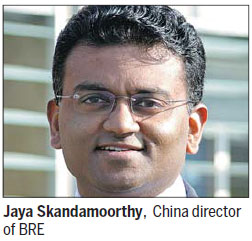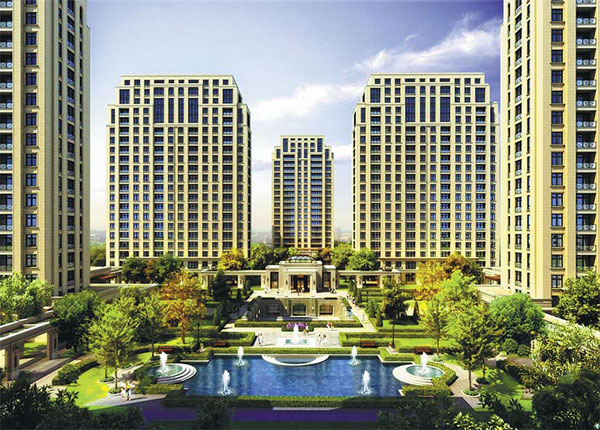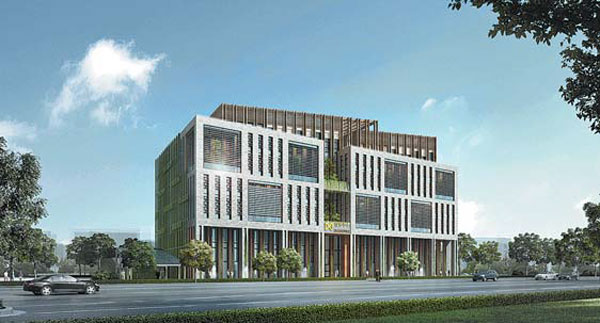Green thumb for growing buildings

China is working with a top UK ratings agency for environmentally friendly structures to develop and showcase cutting-edge technologies
China provides a great opportunity for companies globally to develop innovative green building technologies, says Jaya Skandamoorthy, China director of BRE, the UK rating agency that founded the widely used BREEAM green building standards.
Skandamoorthy says the Chinese government commitment to eco-civilization and environmentally friendly building development, more stringent green building regulations and standards, and competition among local firms, all contribute to China's green building market potential.
| Jin Mao Palace Housing Development in Shanghai was built to meet the BREEAM standard. Photos provided to China Daily |
| A building at Meixi Lake Eco-City, a new community in Changsha, Hunan province. |
BRE, the Building Research Establishment, headquartered in London, is a nonprofit building science organization providing independent research, testing and certification, and training services related to the built environment.
In 1990, it developed BREEAM, the Building Research Establishment Environmental Assessment Methodology, the world's first sustainability standard for assessing a building's environmental performance, which is now used in over 60 countries around the world. The standard is highly regarded in China and has now been used in more than 30 building projects including in Beijing, Shanghai, Shenzhen, Changsha and Guiyang.
Although China has its own green building standards, Skandamoorthy says that increasingly more Chinese projects are choosing to also comply with the international BREEAM standard, which may make it easier to attract international investment and attract foreign firms to their office spaces.
One example is the exhibition center at Meixi Lake Eco-City, a new community in Changsha, Hunan province, developed by Franshion Properties (China) Ltd. The exhibition center is designed to both BREEAM and China's 3 Star green building standard.
"We supported the design of the center, and it had many innovative green building features. One of the most important features is the passive design and natural ventilation, meaning the building does not rely on primary air-conditioning for active cooling, which can consume a lot of energy. The building is very adaptable to changes in the climate of the Meixi Lake area," he says.

A part of BRE's work in China is to align the BREEAM standard with China's climate conditions as well as local regulations and standards such as the China 3 Star green building standard, and potentially make introductions for foreign companies with expertise that can meet both national and international standards and benchmarks.
BRE has formed partnerships with China's leading research organizations such as Tsinghua University, where the two partners are now working on a joint research program for green and low-carbon urbanization that is designed to support the Chinese government's priorities for sustainable development and air quality improvement.
They are also jointly delivering an innovation park in Gui'an New District in Guiyang and its adjacent city Anshun, Guizhou province, that will demonstrate a number of Chinese homes and buildings of the future. To be launched this month, the Gui'an Innovation Park is a strategically important initiative that will help to inform the urbanization strategy for both the Gui'an New District and western China. It also welcomes trial use and showcasing of newly developed technologies, systems and materials for homes and buildings, so they can later be applied to other commercial projects in the region.
Skandamoorthy says that from working with Tsinghua University, and in particular Tsinghua Holding Human Settlement Construction Group, he has realized that there are many innovative green building technologies coming out of China, including smart systems and sensor technologies, cooling and ventilation systems, and prefabricated building technologies.
"These technologies are very advanced, and because the developers in China have economies of scale, they can bring these innovative products to market through a much more commercially viable model," Skandamoorthy says.
For example, the first building being constructed at Gui'an Innovation Park is the visitor center, which has been designed and is being built by the Tsinghua construction group to meet both China 3 Star and BREEAM standards. The building uses many innovative technologies, including energy-saving sensors and a building management system that helps the building to conserve energy and be cost-efficient without compromising the user experience. Some are so advanced that they are leading the world in developing such products and technologies.
These sensors and systems have a large capacity for data monitoring and information management, and they can help to adjust the building's functions and features according to monitoring information on temperature, humidity and other factors. They also make the central building information management system more efficient.
He says that once these cost-efficient and high-performance technologies are tried out in the park, they can also be exported to the world and assist projects globally to conserve energy, improve green building standards and reduce carbon emissions.
The trial stage of the Gui'an Innovation Park will enable the collection of important data and further the research, so that the energy reduction resulting from the green building standards can be well-documented and understood by the end users.
But green buildings are not just about the science of energy reduction that can be measured with statistics. They also mean giving users a comfortable experience and using material supplied locally so that the buildings can be sustainable in the longer term, Skandamoorthy says.
For example, one building inside the park is called the 88 Kilometer House. It aims to have all its construction materials come from within 88 kilometers of the building's location, so carbon transport emissions are reduced and the building can help to develop a local supply chain that benefits the local community.
Once the chain is identified, other companies farther away can be brought in where there are gaps. Such a project will also encourage international companies to establish partnerships and collaborations with local companies, he says.
Green buildings will lead to smaller energy and water bills and also improve comfort, health and well-being levels for the residents, so factors such as air quality, lighting levels and humidity are important.
Skandamoorthy says his team also will invite international companies to showcase their green building technologies inside the Gui'an Innovation Park, which can be a way for them to gain entry to the Chinese market, too.
He says they are also keen to share the best of the UK's advanced green building technologies with China through training and education, and so far it has provided training to many Chinese policymakers and other stakeholders working on green buildings.
Meanwhile, BRE, looking to further develop its presence in China, is preparing to set up a subsidiary in Shenzhen. Last year, it announced an agreement with the Shenzhen government to help the city adopt more green building standards because the city has been chosen to pilot a number of cutting-edge policies on sustainable development.
Given that Shenzhen now requires all new buildings to achieve at least a one-star level in China's national three-star rating system, BRE will work alongside the Shenzhen government to achieve its goals through research and professional training.
"We are excited by the collaboration with Tsinghua University, Shenzhen government and many other Chinese partners, and to support some of the greenest achievements and outcomes in China," Skandamoorthy says.
"We hope our international BREEAM standards, research and training program will provide a platform for leading companies, British and Chinese, to collaborate on green products, technologies and buildings," he says.
cecily.liu@chinadaily.com.cn
(China Daily European Weekly 06/12/2015 page23)
Today's Top News
- Japan tempting fate if it interferes in the situation of Taiwan Strait
- Stable trade ties benefit China, US
- Experts advocate increasing scope of BRI to include soft power sectors
- New engine powers cargo drone expansion
- China to boost green industry cooperation
- Manufacturing PMI rises in November
































